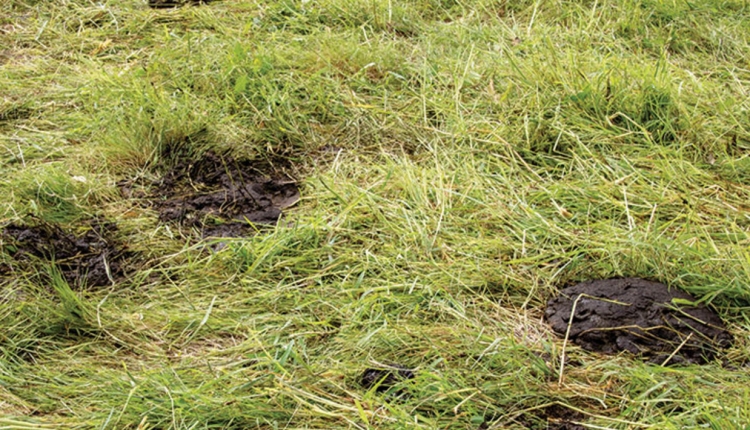The author is a rancher, author, speaker, and consultant with over 40 years of experience in grazing management research, outreach, and practice. He has lived and grazed livestock in hot, humid Missouri and cold, dry Idaho.

Dragging pastures is a spring ritual on many farms and ranches. Also known as harrowing or brushing in different localities, the process is meant to break up manure piles from the previous grazing season or from overwintered livestock. While dragging can certainly make the pastures look prettier, the real question is: “Does an economic benefit result from the practice?” In most cases, the answer is: “It depends.”
There are four main reasons generally put forward as rationale for dragging pastures:
1. Nutrient redistribution and release
2. Seed dispersion
3. Better uniformity of grazing
4. Parasite control
All of these are possible benefits sometimes, but not all of the time, and maybe not to the extent that many people believe.
A fertile square yard
Let’s start with dragging as a nutrient management tool. The first thing to understand is there are natural processes that are working to disperse the manure pile. If a cow stands in one place and defecates, we expect that pile to have a fertility effect on about one square yard by the time birds, insects, rainfall, and so forth all work on the pile. As I talk about how much pasture area is affected by manure each year, picture that in one square yard increments.
In a continuous grazing situation with a moderate to high rainfall environment, manure piles typically land on about 2% of the pasture area each year. Dragging in the spring may disperse manure to cover up to 6% of the area. Remember, cattle will move 30% to 60% of manure to shade and water locations. You are running a tractor and harrow with a driver in the seat to impact a very small part of the pasture, which is probably not cost effective at all.
With daily rotation, we can have manure land on 40% to 50% of the pasture area annually. Dragging pastures with heavy manure coverage can impact 80% to 100% of the pasture area. That could well be cost effective, especially if done in the fall to allow dispersed chunks and particles to come into soil contact over winter.
However, if the soil under the managed pasture has living, functional biology working, then most piles should be disappearing in as little as a couple of months, so the question becomes moot. With functional biology, manure piles decompose from the bottom up. That means breaking the pile-to-soil contact may actually slow manure breakdown.
I can make a stronger argument for the benefit of seed dispersion compared to nutrient redistribution, if you’re relying on natural reseeding to maintain legume stands in your pastures. I think most of us have seen cow pies in the spring completely covered with clover seedlings. How many of those plants actually survive to establish new plants? Not as many as you might think. If manure piles are broken up, especially if done in the fall, more seeds have a greater likelihood of actually getting in contact with the soil.
Intact manure piles do create what is called a “zone of repugnance” around the pile where livestock will not graze if it is manure from their species. Dispersing piles can either reduce or expand the zone of repugnance. If piles are drug when they are wet and soupy, smearing fecal matter over a larger area only promotes selective grazing. Dragging when the piles are drier, but not fully dried out, results in shattering to smaller particles that are less repulsive.
The longer the time period between dragging and the next grazing event, the more beneficial dragging is for enhancing grazing uniformity. For example, dragging in the fall is much more beneficial for reducing selective grazing than is dragging in the spring.
Fall is best
Hopefully, you’ve noted a recurring theme through these first three expected benefits. In each case, dragging pastures in the fall is more beneficial than dragging them in the spring. The ideal time to drag is after the piles have mostly dried but before they freeze. A dried-out summer pile that gets a fall rain on it will usually shatter nicely.
For the most part, I believe dragging pastures in the spring is largely a waste of time and money. Dragging in the fall can have multiple positive benefits.
Dragging for parasite reduction is a different ballgame, as you’re trying to tear up piles to expose eggs and larvae to the sterilizing effect of sunlight. In this case, the sooner after moving stock off the pasture that you drag it, the better the results will be.
Here, smearing soupy manure piles across a larger area is a highly effective way to reduce parasites. Since this operation is more likely to occur in spring or early summer when the probability of rainfall is higher, there is good opportunity for the smeared manure to get washed off the residual forage.
The bottom line is to drag pastures in the fall for agronomic benefits and drag following each grazing event for parasite reduction. Economic benefits are still not guaranteed.
This article appeared in the February 2023 issue of Hay & Forage Grower on page 25.
Not a subscriber? Click to get the print magazine.

